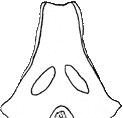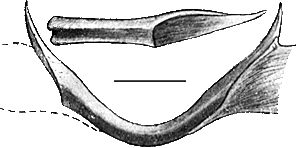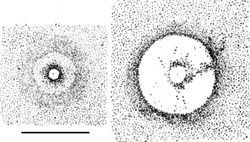Opisthoteuthis pluto: Description Continued
Richard E. Young and Michael Vecchione
- Eyes
- "Moderately large."
- Funnel
- Long and narrow; funnel organ with a pair of well-separated oblique oval pads.

Click on an image to view larger version & data in a new window

Figure. Funnel of O. pluto laid open to show funnel organ. Drawing from Berry (1918).
- Fins
- "...large, flabby, oblong, about twice as broad as long."
- Gills
- Gills with 8 primary lamellae.
- Optic lobes and nerves
- Unknown
- Digestive system
- Digestive gland bilobed (O'Shea, 1999).
- Beaks
- Beaks illustrated but not described.

Click on an image to view larger version & data in a new window

Figure. Lateral view of lower (left) and upper (right) beaks of O. pluto. Drawings from Berry (1918).
- Shell
- Broadly U-shaped.
- Saddle with groove along posterior surface.
- Wings with a vertical thickening, then rapidly tapering, outer surface slightly excavated at point of expansion.

Click on an image to view larger version & data in a new window

Figure. Dorsal (bottom) view of the shell and oblique view of the shell wing (top) of O. pluto. Drawings from Berry (1918).
- Pigmentation
- Upper surfaces with chocolate and dark slate gray.
- Oral surface of web dark chocolate brown, paler toward mouth and periphery.
- Suckers and cirri light brown.
- Oral surface of arms same color as web.
- Areolar spots present (drawings on right): generally appear with small, sharply defined nucleus surrounded by a narrow zone of dark chocolate then a wider paler region which is succeeded by a poorly defined zone of bluish slate.
- Arrangement of areolae uncertain: absent from body; a series beginning between eyes extends along each arm I; similar but less numerous series extend along other arms.

Click on an image to view larger version & data in a new window

Figure. Areolae of O. pluto. Left - areola in contracted state from a medium-sized octopod. Right - areola in expanded state, same animal. Scale bar is 5 mm. Drawings from Berry (1918).
- Measurements and counts
| Sex | ? Holotype | ? | ? Paratype | ? |
| Spread (arm tip to arm tip) | 540 | 350 | 275 | 195 |
| Fin span, mm | 210 | 115 | 115 | 70 |
| Fin length | 60 | 30 | 20 | 10 |
| Fin width | 30 | 15 | 10 | 5 |
| Head width | 100 | 70 | 75 | 30 |
| Arm I, length (right/left) | 260/260 | 160/160 | 145/145 | 85/85 |
| Arm II, length | 250/250 | 155/155 | 150/140 | 85/85 |
| Arm III, length | 270/245 | 170/145 | 140/145 | 90/90 |
| Arm IV, length | 245/250 | 160/160 | 115+/130 | 85/90 |
| Diam. sucker no. 5, arm I | 7 | 4 | 3.5 | 2 |
| Depth web sector A | 170 | 105 | 95 | 60 |
| Depth web sector C | 145 | 95 | 100 | 55 |
| Depth web sector E | 140 | 100 | 80 | 55 |
These measurements and counts are from Berry, 1918.
Comments
The above description is taken from Berry (1918) except where otherwise noted.
References
Berry, S.S. 1918. Report on the Cephalopoda Obtained by the F.I.S. "Endeavour" in the Great Australian Bight and Other Southern Australian Localities. Biological Results of the Fishing Experiments carried on by the F.I.S. "Endeavour", 1909-1914, 4(5):201-298.
O'Shea, Steve. 1999. The Marine Fauna of New Zealand: Octopoda (Mollusca: Cephalopoda). NIWA Biodiversity Memoir 112: 280pp.
About This Page
Richard E. Young

University of Hawaii, Honolulu, HI, USA
Michael Vecchione

National Museum of Natural History, Washington, D. C. , USA
Page copyright © 2003
Richard E. Young
and
Michael Vecchione
 Page: Tree of Life
Opisthoteuthis pluto: Description Continued
Authored by
Richard E. Young and Michael Vecchione.
The TEXT of this page is licensed under the
Creative Commons Attribution-NonCommercial License - Version 3.0. Note that images and other media
featured on this page are each governed by their own license, and they may or may not be available
for reuse. Click on an image or a media link to access the media data window, which provides the
relevant licensing information. For the general terms and conditions of ToL material reuse and
redistribution, please see the Tree of Life Copyright
Policies.
Page: Tree of Life
Opisthoteuthis pluto: Description Continued
Authored by
Richard E. Young and Michael Vecchione.
The TEXT of this page is licensed under the
Creative Commons Attribution-NonCommercial License - Version 3.0. Note that images and other media
featured on this page are each governed by their own license, and they may or may not be available
for reuse. Click on an image or a media link to access the media data window, which provides the
relevant licensing information. For the general terms and conditions of ToL material reuse and
redistribution, please see the Tree of Life Copyright
Policies.


This page is a note that is attached to a
leaf of the Tree of Life.
ToL notes provide brief accounts of characteristics, short summaries,
commentaries, media files, taxonomic information, or identification tools
for a given group of organisms.
For a more detailed explanation of the different ToL page types, have a look at the
Structure of the Tree of Life page.
close box
Page Content
articles & notes
collections
people
options
Explore Other Groups
other Opisthoteuthis
containing groups









 Go to quick links
Go to quick search
Go to navigation for this section of the ToL site
Go to detailed links for the ToL site
Go to quick links
Go to quick search
Go to navigation for this section of the ToL site
Go to detailed links for the ToL site